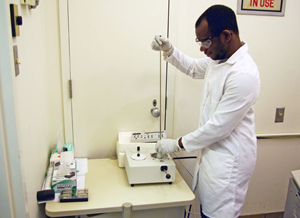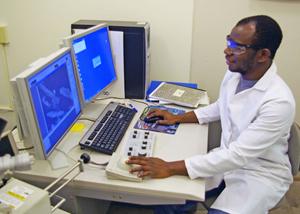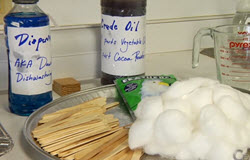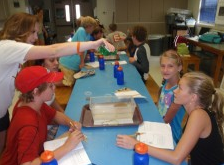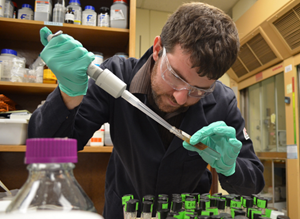
Andrew samples an oil-in-seawater emulsion, stabilized with polymer-coated iron oxide nanoparticles. (Photo provided by Worthen)
Andrew Worthen’s research is “all about discovering how we can steward the planet more responsibly,” something he gets closer to every day. While Andrew’s initial nanoparticle research focused on creating more efficient and eco-friendly oil extraction methods, he is now applying his findings to oil spill treatment and mitigation.
Andrew is a chemical engineering Ph.D. student at the University of Texas at Austin (UT Austin) and a GoMRI scholar with C-MEDS. He shares how he became involved in his research, what it has taught him, and why it is so important.
His Path
Andrew credits his interest in chemical engineering to positive scientific experiences growing up, “I had the great fortune of many good science teachers, even in elementary school; they always kept my scientific interests alive.” As he got older, he felt drawn to chemical engineering, which he describes as the “perfect combination of my interest in chemistry and my math and physics skills. It’s a great marriage of those disciplines.”
A combination of Andrew’s scientific interests and good timing led him to working with C-MEDS. He first heard about the oil spill project, in its early stages, through his advisor, Dr. Keith Johnston. Intrigued by the proposed research, he volunteered to help Johnston move the project forward. Andrew found the work appealing because it combined fundamental science and the larger human goal of treating and mitigating oil spills, which he feels is “vital for the well-being of mankind.”
His Work
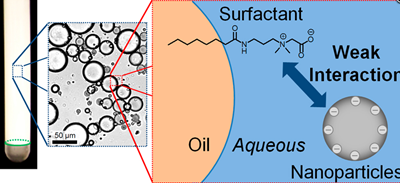
An oil-in-seawater emulsion stabilized with surfactant molecules and nanoparticles acting in synergy, depicted at three scales: a macro-scale view of an emulsion-filled test-tube (left), a microscope image of small spherical oil droplets (center), and a graphic of the nano-scale oil droplet configuration with a surfactant molecule and approaching nanoparticle (right). The surfactant molecules allow formation of smaller oil droplets, and the nanoparticles help stabilize the droplets. When surfactant molecules weakly interact with the nanoparticles, their synergy is strongest. (Provided by Worthen)
At first, Andrew investigated nanoparticles and nanotechnology as tools for drawing out more oil from reservoirs and improving existing surfactant-based dispersants. With C-MEDS, Andrew still handles those materials, but is designing less toxic, more efficient oil spill treatments. He explains, “We found that particles, as small as one-tenth to one-ten-thousandth of a grain of sand, can interact with dispersants and actually improve their performance.”
Andrew’s research often involves discovering new applications for existing knowledge, such as the way a nanoparticle absorbs on the surface of an oil droplet. He gives some background, “The surfaces of untreated oil droplets dispersed in clean water have a charge. Therefore, nanoparticles with the same charge will be repelled, like magnets.” While this concept was already known, Andrew had not yet considered that the charge was significant enough to affect his materials’ performance, “Suddenly, I realized that seawater is so salty that it would actually mitigate repulsion and make the materials work better!” Andrew redesigned the experiment using seawater and likely prevented the premature elimination of a potential solution.
Andrew’s work now encompasses both oil production and mitigation, “supporting both ends of the spectrum: retrieving oil from the ground quickly and safely, while preparing for and dealing with inevitable spills.” He is “in the camp that thinks petroleum production and usage isn’t going away any time soon, so we need figure out how to produce and use oil in a more efficient, green way.”
His Learning
Andrew has grown not only scientifically but also personally: “The thing that this project has taught me—the biggest impact on my learning overall—is how to be a leader.” Originally, it was a small project with just Dr. Johnston and Andrew; then, as the project grew to include undergraduate and graduate students and several post-doctoral researchers, Andrew found himself supervising an entire research team. “It was something I wasn’t expecting,” he explains. “I thought ‘This is a cool little project. No problem, I can take over some of this.’ But then, it suddenly became this very large project, and I ended up being its leader!”
Andrew’s leadership experience grew the most when teaching his fellow team members. Some researchers lacked a colloid background and needed training in that science and laboratory techniques. In his expanded role, Andrew learned to lead by example. “Teaching someone else really makes you know your stuff inside and out,” he says. “You have to know all the fundamentals and practicalities. You can’t just tell somebody ‘Hey, we’re going to do this project, you need to learn all the science.’ You need to be involved. That’s something I’ll remember forever.”
His Future
Andrew is currently transitioning from lab work to writing his dissertation, titled “Generation and Stabilization of Emulsions and Foams with Nanoparticles and Surfactants.” Although graduation is fast approaching, he recently published his work in the January 2014 issue of Langmuir and is finalizing several other journal articles. Additionally, he is preparing to present his GoMRI research at the American Institute of Chemical Engineers this fall. Andrew may pursue a postdoc position to broaden his education before deciding between a profession in academia or the oil industry.
Praise for Andrew
Dr. Johnston speaks highly of Andrew’s leadership, “Leading a research team is essential to multi-disciplinary science and GoMRI work. He did a lot to bring groups together and that ability is a great asset.” Andrew is working on several GoMRI projects with UT Austin scientists, including Thomas M. Truskett (Chairman of the McKetta Department of Chemical Engineering and an expert in soft matter, interfacial phenomena, rheology, and statistical mechanics) and Ph.D. student Jon Bollinger. Johnston commended Andrew’s productive interactions with Vijay John (Tulane) for electron microscopy and Ramanan Krishnamoorti (University of Houston) for polymer science. “Both academia and industry value a multi-disciplinary approach,” he said, “and Andrew is gaining experience in polymer science, colloid science, and inorganic-organic materials chemistry in nanotechnology—all key to moving nanoparticle dispersant research forward.”Conducting research that has “important implications for nanotechnology and enhanced oil recovery in sub-surface reservoirs” and making gains in graduate research education and leadership, Andrew has “an extremely promising future career.”
The GoMRI community embraces bright and dedicated students like Andrew Worthen and their important contributions. The GoMRI Scholars Program recognizes graduate students whose work focuses on GoMRI-funded projects and builds community for the next generation of ocean science professionals.
Visit the C-MEDS website to learn more about their work.
************
This research was made possible in part by a grant from BP/The Gulf of Mexico Research Initiative (GoMRI) to theConsortium for the Molecular Engineering of Dispersant Systems (C-MEDS). The GoMRI is a 10-year independent research program established to study the effect, and the potential associated impact, of hydrocarbon releases on the environment and public health, as well as to develop improved spill mitigation, oil detection, characterization and remediation technologies. An independent and academic 20-member Research Board makes the funding and research direction decisions to ensure the intellectual quality, effectiveness and academic independence of the GoMRI research. All research data, findings and publications will be made publicly available. The program was established through a $500 million financial commitment from BP. For more information, visit http://gulfresearchinitiative.org/.


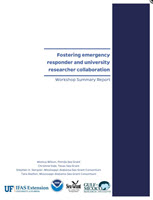


 The
The 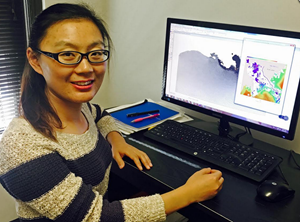
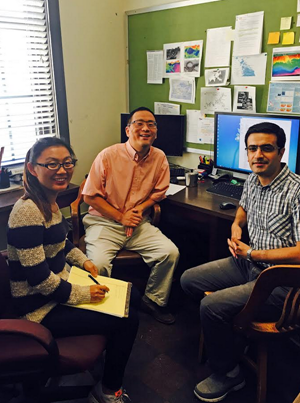


 The
The 
